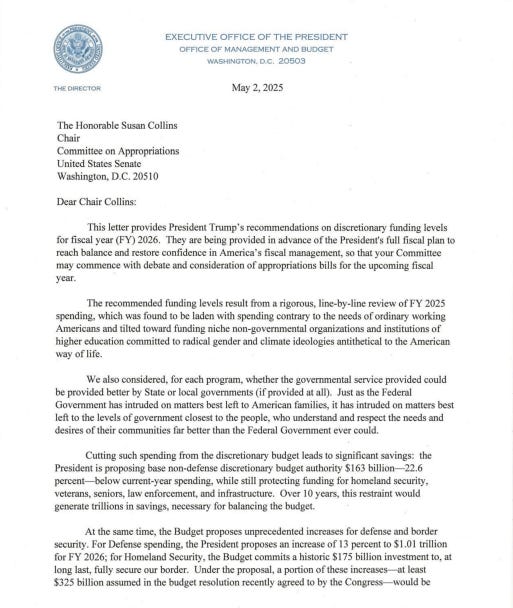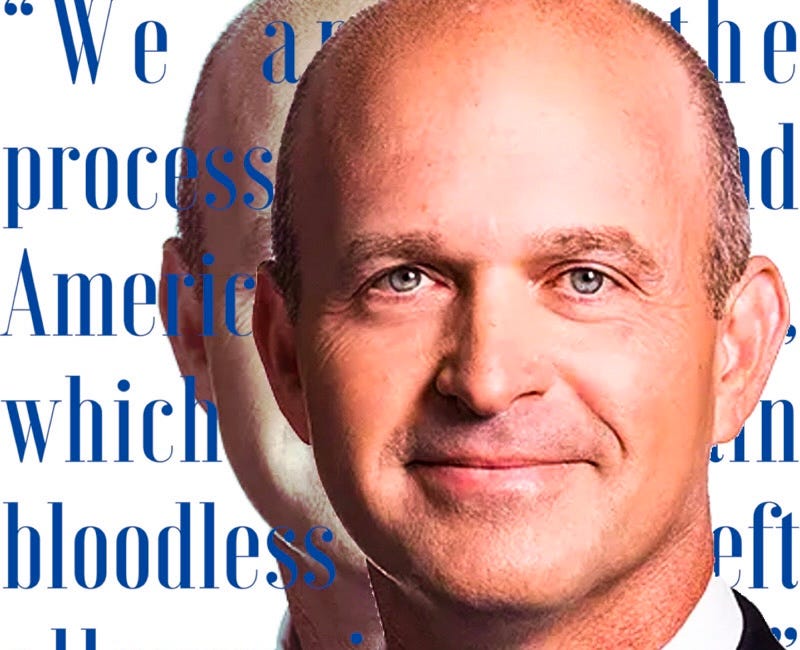The “Skinny Budget”
The Trump Administration’s Discretionary Budget Request (sometimes called a “skinny budget”) dropped today (May 2), and, like many of the administration’s actions, it calls into question the thin premise of then-candiate Trump’s claim during the lead-up to the 2024 election that he had no connection to Project 2025.
The budget, essentially a non-binding wishlist for Congress, proposes $163 billion in cuts to funding for a variety of government programs. (Russel Vought, a self-identified “Christian nationalist” who wrote a piece defending “Christian nationalism” for Newsweek in 2021, and of the masterminds of Project 2025, heads the Administration’s Office of Management and Budget. Vought wrote the cover letter on the budget itself.)
It slashes the total federal education budget by around 15%, according to NPR (while, according to an overview provided by the White House, increasing military spending by about 13%.)
Project 2025
The targets for cuts often align closely with the “blueprint” created by the Project 2025 Mandate for Leadership, a list of goals for the “next conservative presidential administration” from the far-right Heritage Foundation and a list of contributors and sponsors including Moms for Liberty, the “anti-LGBT hate group” Alliance Defending Freedom (ADF), and various pro-voucher and pro-censorship nonprofits and “think tanks” (as well as significant number of individuals who served in Trump’s first administration and/ or would go on to serve in his current administration).
What is Project 2025? (Part I)
Please subscribe or consider upgrading your subscription. Subscribers make this possible.
More money for charter schools
The discretionary budget slashes a long list of Department of Education programs, but it starts, significantly, with a $60 million increase in funding to charter schools. According to the budget, “More local school options are needed, so the Budget invests $500 million, a $60 million increase, to expand the number of high-quality charter schools, which have a proven track record ofimproving students' academic achievement and giving parents more choice in the education oftheir children.”
Of course, the central claim justifying support for charter schools is weak at best. The Department of Education’s own large-scale study found that the impact of charter schools on student achievement was mixed, with negative results for some groups of students and positive groups for others. And while the Project 2025 Mandate for Leadership’s first priorty for education is also assisting charter schools by “rolling back” government regulations, a 2010 literature review by Brookings explicitly urged “collecting and using more and better data on the performance of charter schools for purposes of authorizing, research, and informed parental choice”. Brookings pointed out that “Research findings [on charter school efficacy] vary widely, depending on the schools studied and the research methodology employed” and acknowledged that “knowing that a school is organized as a charter school does not, in and of itself, say much about whether the school is good, bad, or mediocre.”
Title I
The budget then delivers on a key goal of Project 2025— the Mandate for Leadership calls for phasing out Title I funding completely over 10 years— by removing over $4.5 billion from Title I programs (reducing their overall budget to $2 billion).
These programs primarily support lower-income students, with school eligibility tied to Census poverty data. According to the National Center for Education Statistics, in the most recent year for which data was available, “about 63 percent of traditional public schools and 62 percent of public charter schools were Title I eligible.”
As with much of the budget, the summary for these cuts substitutes a vague, unexplained reference to “the distractions of DEI,” in lieu of an explanation for how a 70% cut to programs that help poor students is good for America.
The Individuals with Disablities Education Act (IDEA)
The budget then “consolidates seven Individuals with Disabilities Education Act (IDEA) programs”. No explanation for how this will work is given in this budget, although the Mandate for Leadership suggests that “Most IDEA funding should be converted into a no-strings formula block grant targeted at students with disabilities and distributed directly to local education agencies by Health and Human Service’s Administration for Community Living.”
Updated to add: And with the Office of Civil Rights already gutted, this suggests states will be able to decide for themselves whether to help students with disabilities. (And as others have pointed out, IDEA funding would also now be tied to districts honoring whatever the Administration counts as “parental rights”— a term that in this context usually means erasing discussions of race and rights for LGBTQ+ students, and increased book and content bans. Or, as the author(s) of the budget— presumably including Vought, write, “Parents of students with disabilities would remain empowered to direct these funds because the Federal IDEA law would remain in place; maintaining a base set of Federal funds means they can also be withdrawn from States and districts who flout parental rights.”
The budget also calls for major cuts to federal health spending, including a $3.6 billion cut to the Centers for Disease Control (CDC), and an elimination of its chronic disease center — again justifying the cuts with vague claims about “DEI”— and almost $18 million from the National Institutes for Health.
The exception in this trend of cutting funding for health services is a $500 million increase in spending to support initiatives by Health and Human Services (HHS) Secretary Robert F. Kennedy, Jr., who has a long history of controversial and pseudoscientific claims about the causes of autism, unsupported theories about the dangers of vaccines, and other major health issues. (Kennedy has at times claimed that chemicals in the water make children transgender, that antidepressants lead to school shootings, that HIV doesn’t cause AIDS, and that vaccines cause autism, among other false and dangerous claims.)
In this context, moving IDEA to HHS seems like a potentially major and ominous change.
GEAR UP
The budget cuts funding for GEAR UP programs by $1.6 billion. According to the University of South Carolina, “The Gaining Early Awareness and Readiness for Undergraduate Programs (GEAR UP) initiative is one of the largest and most effective programs focused on increasing the college and career readiness of low-income students in communities nationwide.” (Project 2025, for its part, calls for the total elimination of GEAR UP.)
Targeting migrant students
The budgets also removes $890 million in funding for language programs, with the charged argument that “To end overreach from Washington and restore the rightful role of State oversight in education, the Budget proposesto eliminate the misnamed English Language Acquisition program which actually deemphasizes English primacy by funding NGOs and States to encourage bilingualism.”
This, along with several other cuts to programs benefiting migrant students, suggests that the administration is using the budget to further its sweeping anti-immigrant and anti-migrant agenda.
Defunding the federal Department of Education
Project 2025’s most headline-grabbing education policy was the elimination of the federal Department of Education (ED). The Trump budget telegraphs the same goal in calling for a $127 million decrease in the Department’s administrative budget, explaining that the reduction will come as “the Department winds down its operations and reduces its workforce”.
Teacher Quality Partnerships
During a historic teacher shortage, the budget calls for a $70 million decrease to funding for “Teacher Quality Partnerships,” justifying the move with a series of unsubstantiated claims with the premis that “Federal taxpayer dollars [are] being weaponized to indoctrinate new teachers.”
Claims about students and teachers being “indoctrinated” are peppered throughout the rest of Department of Education section of the budget.
HBCUs
The “skinny budget” recommends a $64 million decrease in federal funding for Howard University. (Interestingly, it avoids the inflammatory language about “wokeness” and “DEI” found in much of the rest of the section on the Department of Education. This feels of a piece with the Mandate for Leadership’s hands-off treatemnt of HBCU’s, suggesting that federal higher education funding be “block granted and narrowed to Historically Black Colleges and Universities (HBCUs) and tribally controlled colleges.” This approach suggests that the both the Mandate and the Trump budget would like to avoid the political ramifications of harming HBCUs.
The Office of Civil Rights
The section ends with a $49 million decrease for the Office of Civil Rights (OCR). This continues the administration’s campaign against the Office, after firing around half of its workforce in March. Traditionally, the OCR provides guidance to public schools on how to comply with civil rights laws, and collects data on how different groups of students are peforming, and on other civil rights-related issues.
The Mandate for Leadership calls for the movement of the OCR from the Department of Education to the Department of Justice, and suggested that it should be stripped of all enforcement mechanisms other than “litigation”.
What does this all mean?
As reported by NPR, “‘Nearly all of these cuts are dead on arrival in Congress,’ said Jessica Riedl, a budget expert at the right-leaning Manhattan Institute. ‘But this may provide a roadmap for where DOGE will go in the next year. If the president can't get this through Congress, he may do as much as possible through executive orders and DOGE.’”
In other words, like the Mandate for Leadership, the budget is essentially a series of suggestions, and will have immediate force only if Congress adopts it into the next budget law. But, also like the Mandate, it gives us a fairly clear sense of what the administration would like to accomplish, and that for education that seems to add up to promoting “alternatives” to traditional public schools while cutting back on programs that protect student civil rights, help students in poverty succeed, and assist students who don’t speak English as their first language to be successful in school.
Thank you for reading. To support this work, please consider a donation or paid subscription.
Further reading…
May 1, 2019
This piece was originally made possible by the Center for Educator Wellness and Laerning (CEWL).






